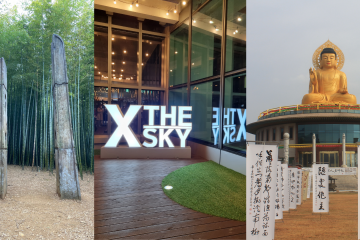Chuseok holiday: What you should know about it

Many don’t know about South Korea’s different holidays and traditions, and Chuseok (Hangawi) is one of them. Coming up around the corner, Chuseok is a three-day holiday following the lunar calendar. It lands on the 15th day of the 8th month on the full moon, and this year it is September 30th through October 2nd.
Table of Contents
What is Chuseok?
Chuseok, Autumn Eve, is a harvest festival around the autumnal equinox where people celebrate the harvest, hope for a better one next year, and pay respects to their ancestors. Some call it the Korean Thanksgiving.
Its origins aren’t very clear, but some suspect it came from a month-long weaving contest from the time of the third king of Silla 2,000 years ago called Gabae. Others think it came from a celebration over the defeat of Silla’s rival kingdom. It also could have come from ancient celebrations and rituals for the harvest moon. Regardless of where it came from, it is now a popular, long-standing tradition in both North and South Korea.
Chuseok holiday: Then vs. Now
Some traditions are Charye, Beolcho, and Seongmyo. Charye is an ancestral ritual where families come together for an elaborate spread of food dedicated to their ancestors. The family typically bows twice for the dead and once for the living before eating the spread (also referred to as Eumbok).
Beolcho is the tradition where families go to their ancestor’s gravesite to cut the grass, clear any debris, and clean the surrounding area. It shows respect for the dead and is the preparation for Seongmyo.
The last major tradition is Seongmyo, which is a bowing ritual. This happens on the day of Chuseok and involves family visitation at the cleaned gravesite and bowing in respect.
For Chuseok, some wear Hanbok—traditional Korean clothing. Traditionally, people wore Hanbok regularly, but now people wear it for special occasions. For Chuseok specifically, there is Chuseokbim, which can be rented out or bought for the holiday. Some Hanboks rent for 10,000 – 30,000 KRW a day. For more information about Hanbok, check this out.
Nowadays, not everyone participates in these long-standing traditions or wears traditional wear. According to chuseok.info, some go on a vacation instead, or they wear regular clothing. Another separation from tradition is the ancestral table for Charye—not everyone is strict with the traditional set-up of the table anymore.
Chuseok Holiday Festivities and Games
Chuseok holiday has many traditions, but there are also games and festivities to join as well. There are folk games called Jeontongnori. These are usually played around family or at traditional sites around the country with several people.
Some popular games and events are tug-of-war (Juldarigi), a wrestling event (Ssireum), chicken-fighting (Dalkssaum), Go-Stop (a card game played with Hwatu), or even traditional dancing (Ganggangsullae).
If one decides to not join the folk games, then they can check out the Chuseok television specials. The Chuseok bang songpyeon seongpyo, or the Chuseok broadcast schedule, is a popularly searched term online. During this time, the popular channels play popular tv shows, movies, variety shows, and even the Idol Star Championships (a K-Pop idol sports event).
So as one can see, there’s plenty to do for this holiday season.
Food
Food is always an important aspect of any holiday, and with Chuseok, it’s definitely a focus. Charye, as mentioned above, is when families cook all kinds of dishes and side dishes for the family and their ancestors. Cooking can last all day!
Some traditional dishes are:
Songpyeon – a small rice cake made of red beans, chestnuts, sesame, and other fillings.
Tteokguk – a soup made for New Year’s and sometimes Chuseok with sliced rice cakes and meat broth.
Fruit – popular Korean fruit like pears, jujubes, and persimmons are usually added to the table set-up for Charye and may be expensive during this time.
Hangwa – Korean confections used for special events and are also on the Charye table for Chuseok.
Namul – are a variety of side dishes (banchan) and usually made with vegetables. Korean cuisine has many side dishes with their entrees.
To pair with these dishes, people may drink rice wines or liquor like soju or makgeolli. It may even make its way to the Charye table.
Essentials and Expenses
Chuseok has many moving parts, and as a foreigner or a guest, it may be pretty confusing. If invited to a Chuseok gathering, what is the proper etiquette?
One thing to understand is that gifts are not only popular but polite to bring. In fact, many sets sell during Chuseok, so be sure to bring a gift for the hosts and friends. There is a variety of them, ranging from Spam gift sets to soaps.
However, many stores are closed on Chuseok, so be sure to grab a gift the day before when everything is on sale.
Another thing to remember for etiquette is greetings. When greeting others on Chuseok, you may want to remember a few greetings:
- “Have a full-hearted and generous Hangawi.”
- “Have a nice Chuseok with your family.”
- “Have a happy Chuseok with a bright full moon.”
- “Have a rich and leisurely Hangawi.”
- “Have a full-hearted Chuseok like the full moon.”
Check out the link above to find the Korean translations, so you can learn them for Chuseok.
The last thing to remember is that traveling around the country is tricky during this time. Everyone is going home or on vacation, so traffic can be congested for the whole three days of Chuseok. Even though travel, renting Hanbok, buying gifts, and even buying food for the holiday can be expensive, there is still the opportunity to use discounts and deals.
After the preparation and hard work, be sure to relax and have fun! It’s always great to learn about another culture and to remember to give thanks. I hope you all have a rich and leisurely Hangawi.
To learn more about Korean culture, check out Kworld Now.








